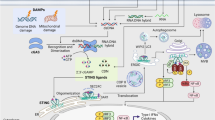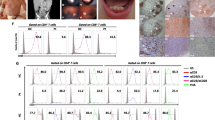Abstract
Spironolactone (SPIR) binds to cytoplasmic mineralocorticoid receptors (MR) and functions as an aldosterone (ALDO) antagonist. Recently, however, the drug was shown to have an early MR independent, suppressive effect on immunoactive and inflammatory cytokines as well as an apoptotic effect on blood mononuclear cells (MNC). To elucidate the mechanism behind SPIR’s apoptotic effect, we investigated the relation between apoptosis and cytokine suppression for SPIR along with the apoptosis-inducing and antiinflammatory drug sulfasalazine (SFZ). Using human MNC, we found that SPIR and SFZ, at concentrations 10 and 1000 μM, respectively, significantly increased both apoptosis and cell death. Production of inflammatory cytokines was significantly reduced by 3 to 30 μM SPIR and by 300 to 1000 μM SFZ. We also found that 0.4 μM SPIR and 300 μM SFZ significantly reduced the activity of NF-κB, a transcription factor involved in both apoptosis and immunoinflammation. ALDO, the MR antagonist, eplerenone, and the SPIR metabolite, 7α-thiomethyl-spironolactone, slightly reduced NF-κB activity, but they did not interfere with SPIR’s effect, showing that MR binding is not involved in SPIR-induced suppression of NF-κB activity. Finally, phosphorylation of IκBα was also significantly reduced by SPIR. These results provide new insight into the apoptotic and anti-inflammatory effects of SPIR.
Similar content being viewed by others
Abbreviations
- 7TS:
-
7α-thiomethyl-spironolactone
- ALDO:
-
Aldosterone
- CD:
-
Crohn’s disease
- EPL:
-
Eplerenone
- GM-CSF:
-
Granulocyte-macrophage colony-stimulating factor
- IFN:
-
Interferon
- IL:
-
Interleukin
- IkBα:
-
Inhibitor of κ light chain gene enhancer in B cells
- LPS:
-
Lipopolysaccharide
- MNC:
-
Mononuclear cells
- MR:
-
Mineralocorticoid receptor
- NF-κB:
-
Nuclear factor κB
- PBS:
-
Phosphate buffered saline
- PHA:
-
Phytohaemagglutinin-A
- PI:
-
Propidium iodide
- RA:
-
Rheumatoid arthritis
- SFZ:
-
Sulfasalazine
- SPIR:
-
Spironolactone
- TNF:
-
Tumour necrosis factor
References
Sonenshein GE (1997) Rel/NF-kappa B transcription factors and the control of apoptosis. Semin Cancer Biol 8:113–19
Pahl HL (1999) Activators and target genes of Rel/NF-kappaB transcription factors. Oncogene 18:6853–866
Ali S, Mann DA (2004) Signal transduction via the NF-kappaB pathway: A targeted treatment modality for infection, inflammation and repair. Cell Biochem Funct 22:67–9
Chen LF, Greene WC (2004) Shaping the nuclear action of NF-kappaB. Nat Rev Mol Cell Biol 5:392–01
Delhalle S, Blasius R, Dicato M, Diederich M (2004) A beginner’s guide to NF-kappaB signaling pathways. Ann N Y Acad Sci 1030:1–3
Los LE, Colby HD (1994) Binding of spironolactone metabolites in vivo to renal mineralocorticoid receptors in guinea pigs. Pharmacology 48:86–2
Klauber N, Browne F, Anand-Apte B, D’Amato RJ (1996) New activity of spironolactone. Inhibition of angiogenesis in vitro and in vivo. Circulation 94:2566–571
Fiebeler A, Schmidt F, Muller DN, et al (2001) Mineralocorticoid receptor affects AP-1 and nuclear factor-kB activation in angiotensin II-induced cardiac injury. Hypertension 37:787–93
Sun Y, Zhang J, Lu L, Chen SS, Quinn MT, Weber KT (2002) Aldosterone-induced inflammation in the rat heart : Role of oxidative stress. Am J Pathol 161:1773–781
Matsumoto R, Yoshiyama M, Omura T, et al (2004) Effects of aldosterone receptor antagonist and angiotensin II type I receptor blocker on cardiac transcriptional factors and mRNA expression in rats with myocardial infarction. Circ J 68:376–82
Sanz-Rosa D, Cediel E, de las Heras N, et al (2005) Participation of aldosterone in the vascular inflammatory response of spontaneously hypertensive rats: role of the NFkappaB/IkappaB system. J Hypertens 23:1167–172
Bendtzen K, Hansen PR, Rieneck K, The Spironolactone/Arthritis Study Group (2003) Spironolactone inhibits production of proinflammatory cytokines, including tumor necrosis factor alpha and interferon-gamma, and has potential in the treatment of arthritis. Clin Exp Immunol 134:151–58
Hansen PR, Rieneck K, Bendtzen K (2004) Spironolactone inhibits production of proinflammatory cytokines by human mononuclear cells. Immunol Lett 91:87–1
Grauballe MC, Bentzen BH, Bjornsson M, et al (2005) The effect of spironolactone on experimental periodontitis in rats. J Periodontal Res 40:212–17
Sønder SU, Mikkelsen M, Rieneck K, Hedegaard CJ, Bendtzen K (2006) Effects of spironolactone on human blood mononuclear cells: Mineralocorticoid receptor independent effects on gene expression and late apoptosis induction. Br J Pharmacol 148:46–3
Mikkelsen M, Sonder SU, Nersting J, Bendtzen K (2006) Spironolactone induces apoptosis in human mononuclear cells. Association between apoptosis and cytokine suppression. Apoptosis 11:573–79
Wahl C, Liptay S, Adler G, Schmid RM (1998) Sulfasalazine: A potent and specific inhibitor of nuclear factor kappa B. J Clin Invest 101:1163–174
Jue DM, Jeon KI, Jeong JY (1999) Nuclear factor kappaB (NF-kappaB) pathway as a therapeutic target in rheumatoid arthritis. J Korean Med Sci 14:231–38
Liptay S, Fulda S, Schanbacher M, et al (2002) Molecular mechanisms of sulfasalazine-induced T-cell apoptosis. Br J Pharmacol 137:608–20
Garthwaite SM, McMahon EG (2004) The evolution of aldosterone antagonists. Mol Cell Endocrinol 217:27–1
Williams TA, Verhovez A, Milan A, Veglio F, Mulatero P (2006) Protective effect of spironolactone on endothelial cell apoptosis. Endocrinology 147:2496–505
Akahoshi T, Namai R, Sekiyama N, Tanaka S, Hosaka S, Kondo H (1997) Rapid induction of neutrophil apoptosis by sulfasalazine: implications of reactive oxygen species in the apoptotic process. J Leukoc Biol 62:817–26
Habens F, Srinivasan N, Oakley F, Mann DA, Ganesan A, Packham G (2005) Novel sulfasalazine analogues with enhanced NF-kB inhibitory and apoptosis promoting activity. Apoptosis 10:481–91
Lappas M, Yee K, Permezel M, Rice GE (2005) Sulfasalazine and BAY 11-7082 interfere with the nuclear factor-kappa B and I kappa B kinase pathway to regulate the release of proinflammatory cytokines from human adipose tissue and skeletal muscle in vitro. Endocrinology 146:1491–497
Takamura N, Maruyama T, Ahmed S, Suenaga A, Otagiri M (1997) Interactions of aldosterone antagonist diuretics with human serum proteins. Pharm Res 14:522–26
Author information
Authors and Affiliations
Corresponding author
Additional information
Financial support: The Danish Research Agencies, the Danish Rheumatism Association, the Carla Thiel Foundation and the Danish Biotechnology Program.
Rights and permissions
About this article
Cite this article
Sønder, S.U.S., Woetmann, A., Ødum, N. et al. Spironolactone induces apoptosis and inhibits NF-κB independent of the mineralocorticoid receptor. Apoptosis 11, 2159–2165 (2006). https://doi.org/10.1007/s10495-006-0286-3
Published:
Issue Date:
DOI: https://doi.org/10.1007/s10495-006-0286-3




